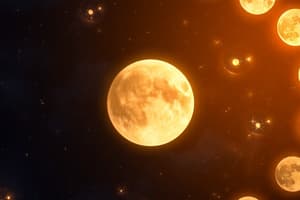Podcast
Questions and Answers
What is the distinguishing feature of a Waxing Gibbous moon phase?
What is the distinguishing feature of a Waxing Gibbous moon phase?
- A small portion of the Moon is illuminated
- Most of the Moon's near side is illuminated (correct)
- About half of the Moon is illuminated
- Only a thin crescent is illuminated
Which phase of the moon follows the Waxing Crescent phase?
Which phase of the moon follows the Waxing Crescent phase?
- Waning Gibbous
- Full Moon
- First Quarter (correct)
- New Moon
How long does it take for the Moon to go from one New Moon to the next New Moon?
How long does it take for the Moon to go from one New Moon to the next New Moon?
- 31 days
- 30 days
- 27.3 days
- 29.5 days (correct)
What is the distinctive characteristic of the Full Moon phase?
What is the distinctive characteristic of the Full Moon phase?
What is the appearance of the moon during the First Quarter phase?
What is the appearance of the moon during the First Quarter phase?
What is the main reason for the Moon's changing shape, known as phases?
What is the main reason for the Moon's changing shape, known as phases?
During a New Moon, why is the Moon not visible from Earth?
During a New Moon, why is the Moon not visible from Earth?
What phase of the Moon comes immediately after a New Moon?
What phase of the Moon comes immediately after a New Moon?
During a First Quarter Moon, how much of the Moon's near side is illuminated?
During a First Quarter Moon, how much of the Moon's near side is illuminated?
What distinguishes a Waxing Gibbous Moon from a Full Moon?
What distinguishes a Waxing Gibbous Moon from a Full Moon?
Why does a Full Moon appear opposite to the Sun?
Why does a Full Moon appear opposite to the Sun?
Flashcards
Moon Phases
Moon Phases
The changing appearance of the Moon caused by its position relative to Earth and the Sun.
New Moon
New Moon
The phase when the Moon is between the Earth and the Sun, making it invisible from Earth.
Waxing Crescent
Waxing Crescent
The phase following New Moon where a small sliver of the Moon becomes visible.
First Quarter
First Quarter
Signup and view all the flashcards
Waxing Gibbous
Waxing Gibbous
Signup and view all the flashcards
Full Moon
Full Moon
Signup and view all the flashcards
Waning Gibbous
Waning Gibbous
Signup and view all the flashcards
Last Quarter
Last Quarter
Signup and view all the flashcards
Waning Crescent
Waning Crescent
Signup and view all the flashcards
Moon Cycle Duration
Moon Cycle Duration
Signup and view all the flashcards
Study Notes
Understanding Moon Phases
As Earth orbits around the Sun, the Moon appears to change its shape month after month due to its ever-changing position relative to the Sun and Earth. These alterations are known as the Moon's phases, and they result from the interconnected dance of the Sun, Moon, and Earth.
The Moon doesn't produce its own light; it reflects the Sun's rays. The side of the Moon facing the Sun is illuminated, while the side facing away is dark. Our view of the lit side changes as the Moon orbits Earth, creating the Moon's phases.
New Moon
A New Moon occurs when the Sun, Moon, and Earth align, with the Moon positioned between the Earth and the Sun. The side of the Moon facing Earth is dark, rendering it invisible to us.
Waxing Crescent
After a New Moon, the Moon becomes visible as a thin crescent, marked by a small sliver of illuminated surface. This phase is called the Waxing Crescent.
First Quarter
A First Quarter Moon appears as a half-moon, with half of the Moon's near side illuminated.
Waxing Gibbous
The Waxing Gibbous phase occurs when the Moon is more than half illuminated and is still increasing in illumination. The term "gibbous" refers to a convex bulge, like the back of a camel.
Full Moon
A Full Moon occurs when the Sun, Earth, and Moon align with the Moon opposite the Sun—that is, when Earth is between the Sun and the Moon. The entire face of the Moon is illuminated, and it appears full for a couple of days before moving into its waning phase.
Waning Gibbous
When the Moon is past Full but not yet Third Quarter, it's in the Waning Gibbous phase. The Moon is most of the way illuminated, with a small portion gradually darkening.
Last Quarter
The Last Quarter Moon, also known as a Third Quarter Moon, appears as a half-moon, with half of the Moon's near side illuminated, opposite the First Quarter Moon's appearance.
Waning Crescent
The Waning Crescent is the thin crescent of illuminated surface opposite to the Waxing Crescent.
Each of these phases follows the other as the Moon moves through its cycle, taking about 27.3 days to complete one full orbit. However, due to the Moon's orbit around Earth, it takes about 29.5 days to go from one New Moon to the next New Moon.
Studying That Suits You
Use AI to generate personalized quizzes and flashcards to suit your learning preferences.



